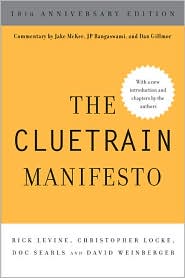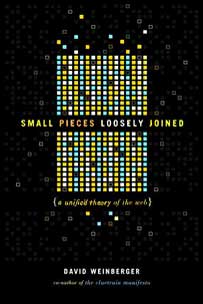June 10, 2011
[hyperpublic] Final panel: Cooperation without Coercion
At the final panel of the conference. Judith Donath is moderating.
|
NOTE: Live-blogging. Getting things wrong. Missing points. Omitting key information. Introducing artificial choppiness. Over-emphasizing small matters. Paraphrasing badly. Not running a spellpchecker. Mangling other people’s ideas and words. You are warned, people. |
Charlie Nesson asks: “When we talk about our space, who are we?” In Jeff Huang‘s presentation, it seemed like he was given the perfect hypothetical — a desert — to build a public and private place. “In cyber terms, we are people of the Net. What then is our domain? It’s the public domain. And if you are to build the public domain, then I believe the wisdom to follow from a lawyer’s point of view is the same wisdom that has more or less informed the world of real property. If you want an orderly world of real property, you build a registry. If you want an orderly world of bits, you build a registry.” This is Charlie’s new project: a registry of the public domain. They’re starting with IMSLP.org: a musical score library. It has 93,000 musical scores in the public domain., exquisitely put together.
The Net divides into two domains, says Charlie, one that is free and one that is not. Free means free of copyright and other encumbrances. Charlie wants to build our domain on a foundation solid in law. The registry he’s building identifies works as public domain, with links to the registrars attesting to this. He wants it to be populated by librarians with public domain collections. But, the problem with registries is litigation risk, i.e., the threat of lawsuit. “So the essence of this idea is to couple the registrar with a pro bono commitment of legal service from a law firm of repute to defend litigation based on infringement.”
Where do you find the institutions that want to protect privacy, asks Charlie. How about libraries, he suggests?
“I’m tough on privacy, Judith,” says Charlie, in response to a question. “I’ve never liked it.” He explains it’s so often based on fear and looks backwards.
Martin Nowak looks at cooperation evolutionary term in which a donor pays a cost and a recipient gets a benefit. He explains game theory’s Prisoner’s Dilemma. Why do people cooperate? “Natural selection chooses defection,” rather than cooperation. In a mixed population, defection becomes increasingly more popular. So, natural selection needs help to favor co-operation. Martin categorizes the factors into five mechanisms: kin selection, direct reciprocity, indirect reciprocity spatial selection and group selection.
Direct reciprocity (I help you, you help me). If you play the Prisoner’s Dilemma several times, the economics changes, as The Folk Theorem shows them. Martin quickly summarizes Axelrod and Rapaport. [Too hard to live blog. Read Ethanz. Really. Now.] Errors turn out to ruin cooperation, so you need a process that allows for forgiveness. Martin’s doctoral dissertation showed that if everyone plays randomly, the right tactic is to always defect. A tit for tat strategy corrects that, and generous tit-for-tat (I may still cooperate even if you defect) provides a math model for the evolution of forgiveness and cooperation. There are always oscillations; cooperations are never stable. We need structures that rebuild cooperation quickly after it is destroyed because it always will be destroyed.
Direct reciprocity allows allow for the evolution of cooperation if there’s a prospect of another round. Indirect reciprocity (I help you, someone helps me) leads to cooperation if reputation matters. You need natural selection to care about reputation, so to speak. “What you need for indirect reciprocity is gossip” to spread reputation. For that you need language. “You could argue this is the selection process that led to language.” “For direct reciprocity you need a face. For indirect reciprocity you need a name.” (David Haig) Our brain has both capabilities. If interactions are completely anonymous you run into problems. Also, you need gossip to be relatively honest.
Spatial selection = neighbors help each other. Martin flips through some graphs that shows that it selects for coop if you have a few close friends. Likewise, evolutionary set theory says that people wanting to join particular groups can also lead to coop.
Judith: What about strong vs. weak ties?
Martin: We assume equal ties. There’s a trade-off between wealth and vulnerability.
Nicholas Negroponte asks himself a question every morning: Is he doing something that normal market forces would do anyway? If so, he stops. He wants to do that which market forces will not do.
There are now 3M One Laptop Per Child laptops in the hands of kids. This isn’t huge since OLPC would like to get laptops into the hands of about 500M kids. Before that, people assumed computers teach by imparting content. Instead, you want to see children teaching. 20-30% of the million Peruvian kids with OLPC machines are using them to teach their parents how to read.
Nicholas goes through some points he made in a talk at the UN recently. Among the points: Measurement is overrated. You only measure when the changes are so small that you can only see them by measurement.
Judith: When we see well-off kids sitting side by side looking into screens, we think it’s a nightmare of anti-sociality, but when we see your adorable photos of third world kids in the same position, it looks desirable?
Nicholas: I don’t see the well-off kids that way. And why don’t we make OLPC’s available in the US? Because the issues are deeper than that.
A: Talk about anonymity…?
Jeff Jarvis: It’s foundational to democracy. It’s getting a bad name because of trolls. But it must be protected.
Q: This discussion is soaked in privilege. There’s much inscribed in the language that affects how people act. When you idolize the public space as a place where all can share their ideas safely, it feels really far away for me.
Q: (Charlie) Nicholas, you’ve said that Uruguay has given all 500,000 of its kids OLPCs. Given your position on measurement, what change will we see?
Nicholas: Their curiosity, the way they approach problems, the way they look at things…I think you’re going to see a nation that is far more creative than many other nations. Nicholas tells a story of kid whose homework got 100K hits.
Martin: Who teaches them how to use it?
Nicholas: It’s genetic :) We’re going to do a scientific experiment in which we drop OLPC laptops out of helicopters onto remote villages and come back in a year and see how many have learned how to read.
Q: (urs gasser) One vision says build a great tool and see what happens. The other is to study human behavior scientifically. (Nicholas vs. Martin). How difficult is the translation from findings from science about human behavior to adapting them to technology?
Martin: I’m fascinated by mathematics, but we do apply it to practical issues. In the field of cooperation, we’d like to bring the models closer to human observations. For example, many cultures like punishment, but I think it doesn’t work well to create cooperation because it creates complications. Reward seems better. So, we study that. We do the same experiment in multiple cultures. In Romania, for example, people differentiated between public and private outcomes, because they lacked faith that public engagement had positive outcomes.
Q: (zeynep) The Net has let the cooperative side of human nature be more manifest. Does your work in evolutionary biology take account of this?
A: The coop we see in the animal world must rely on direct observation. Humans can communicate. We don’t have to rely on our personal experience with another to decide whether to coop. The Net can help us to evaluate others quickly.








